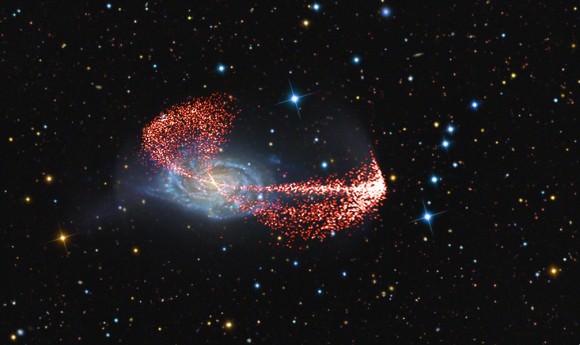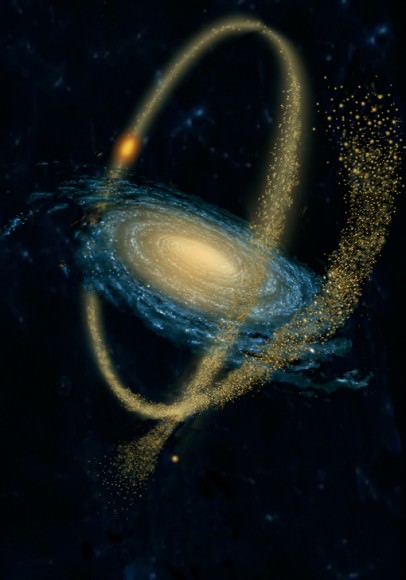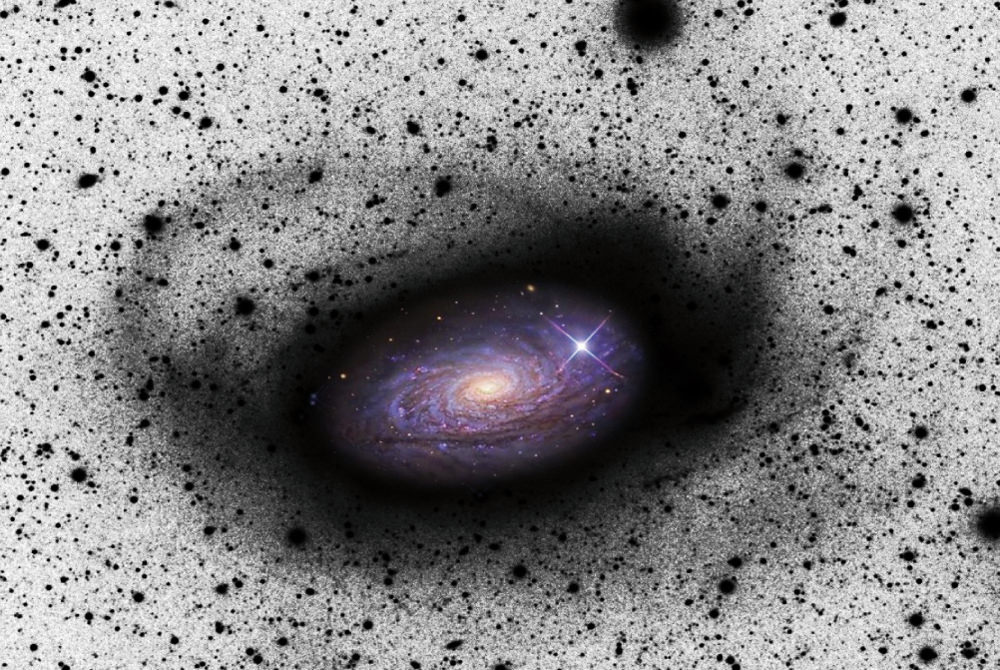[/caption]
For years, astronomers have seen evidence that – at least in our own local neighborhood — spiral galaxies are consuming smaller dwarf galaxies. As they are digested, these dwarf galaxies are severely distorted, forming structures like strange, looping tendrils and stellar streams that surround the cannibalistic spirals. But now, for the first time, a new survey has detected such tell-tale structures in galaxies more distant than our immediate galactic neighborhood, providing evidence that this galactic cannibalism might take place on a universal scale. Remarkably, these cutting-edge results were obtained with small, amateur-sized telescopes.
Since 1997, astronomers have seen evidence that spirals in our local group of galaxies are swallowing dwarfs. In fact, our own Milky Way is currently in the process of eating the Canis Major dwarf galaxy and the Sagittarius dwarf galaxy. But the Local group with its three spiral galaxies and numerous dwarfs is much too small a sample to see whether this digestive process is happening elsewhere in the Universe. But an international group of researchers led by David Martínez-Delgado from the Max Planck Institute for Astronomy recently completed a survey of spiral galaxies at distances of up to 50 million light-years from Earth, discovering the tell-tale signs of spirals eating dwarfs.
For their observations, the researchers used small telescopes with apertures between 10 and 50 cm, equipped with commercially available CCD cameras. The telescopes are located at two private observatories — one in the US and one in Australia. They are robotic telescopes that can be controlled remotely.
During the “eating” process, when a spiral galaxy is approached by a much smaller companion, such as a dwarf galaxy, the larger galaxy’s uneven gravitational pull severely distorts the smaller star system. Over the course of a few billions of years, tendril-like structures develop that can be detected by sensitive observation. In one typical outcome, the smaller galaxy is transformed into an elongated “tidal stream” consisting of stars that, over the course of additional billions of years, will join the galaxy’s regular stellar inventory through a process of complete assimilation. The study shows that major tidal streams with masses between 1 and 5 percent of the galaxy’s total mass are quite common in spiral galaxies.

Detailed simulations depicting the evolution of galaxies predict both tidal streams and a number of other distinct features that indicate mergers, such as giant debris clouds or jet-like features emerging from galactic discs. Interestingly, all these various features are indeed seen in the new observations – impressive evidence that current models of galaxy evolution are indeed on the right track.

The ultra-deep images obtained by Delgado and his colleagues open the door to a new round of systematic galactic interaction studies. Next, with a more complete survey that is currently in progress, the researchers intend to subject the current models to more quantitative tests, checking whether current simulations make the correct predictions for the relative frequency of the different morphological features.
While larger telescopes have the undeniable edge in detecting very distant, but comparatively bright star systems such as active galaxies, this survey provides some of the deepest insight yet when it comes to detecting ordinary galaxies that are similar to our own cosmic home, the Milky Way. The results attest to the power of systematic work that is possible even with smaller instruments.
For more images see this page from the Max Planck Institute for Astronomy
*Note: Originally the lead image image was credited incorrectly, and is actually a product of R. Jay Gabany, an astrophotographer whose work has been featured quite often here on Universe Today. See more of his amazing handiwork at his website, Cosmotography.


Resistance is futile; you will be assimilated!
It is the copernican priinciple: If it is commonly observed locally it should then be universal. Gravity is a sort of entropy force, and with the increase in the clumpling of matter entropy increaes.
LC
Segue 1 Galaxy has only 1,000 stars mostly of solar mass, and is very close to our Milky Way galaxy. Because of contstant orbital velocities around the central black hole, Simon’s team determined that the galaxy is 500x more massive then its stars. Practically all scientists believe that this nearby galaxy has the more dark matter then any discovered galaxy in the universe! It is clearly a violation of the Copernican principle. I’m sure we really have the most massive dark matter galaxy lurking right near us! Look at above photo of the curving shapes of the spiral arms orbiting in thin curving strings, and honestly tell me, do you really believe that a lot of required dark matter gravity is doing this? Tidal streaming dwarf galaxies have more dark matter then anything else, simply because the stars would fly apart away from the galaxy. That’s all….to make money on balogne…no detected invisible particles have ever been discovered. Hooke’s law and black holes is better then assigning huge dark matter gravity amounts to tiny galaxies with a few far outermost orbiting stars that have strange loops but don’t fly away!
Hooke’s Law is Newton’s Law of Motion and Kepler’s Law around black holes. The force increases the farther away THE STAR gets from the black hole. that’s why shapes get thinner more curved as go farther out, and the force keeps the individual outermost stars from flying apart and maintains the galaxy shapes. The more force just to keep a star in the galaxy, the more dark matter they must come up with for fewer stars likely orbiting intermediate sized black holes forming tiny dwarf galaxies. Yet globular clusters swap galaxies but individual stars do not get away? Obviously globular clusters have black holes inside them, which tugs these ancient star clusters differently then individual stars not in a globular cluster and which do not escape the galaxy. Hooke’s Law and Black HoleS explains this far better then does dark matter theory, which originated because of the absolute belief in the Big-Bang Theory. Sure, the standard cosmological model is that which has been tested, but much remaining is unexplainable without dark matter. Superclusters are so vast that each of their entire lengths cannot be seen in our limited visible universe, and when the more powerful telescopes to be built can see beyond the other side of the Shapley and Great Attractor, I see no doubt that far more astonishing mega-gigantic huge cosmological structures will be discovered that will require hundreds of billions of years to even form…and so on outwards ! Then we will see that the standard model is just that, a model for the Universe and why dark matter will be demised. That the Big-Bang is not the absolute beginning for the universe, nor an absolute reference frame of no motion no anistropies which the CMB is not.
That’s not right — that’s not even wrong!
That’s not right – that’s not even wrong!
Excuse me for the double post — it was due to the first one initially failing to appear.